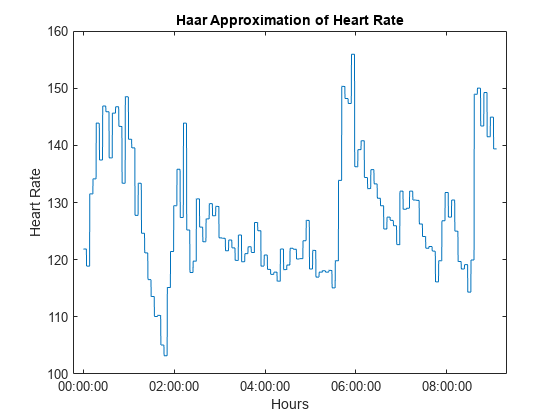ihaart
Inverse 1-D Haar wavelet transform
Description
xrec = ihaart(___,integerflag)
Examples
Obtain the Haar and inverse Haar transforms of noisy data.
Load the noisy data signal
load noisdopp;Obtain the Haar transform of the noisy signal.
[a,d] = haart(noisdopp);
Reconstruct the data by inverting the Haar transform.
xrec = ihaart(a,d);
Compare the original and reconstructed data by determining the maximum difference between them. The difference is essentially zero, which indicates a near-perfect reconstruction.
max(abs(xrec-noisdopp'))
ans = 4.4409e-15
Obtain the Haar transform and inverse Haar transform of ECG heart rate data.
Load and plot the ECG data.
load BabyECGData; plot(times,HR) xlabel('Hours') ylabel('Heart Rate') title('ECG Data')

Obtain the Haar transform and inverse Haar transform. Compare the reconstructed data at level 4 to the original data.
[a,d] = haart(HR); HaarHR = ihaart(a,d,4); figure plot(times,HaarHR) xlabel('Hours') ylabel('Heart Rate') title('Haar Approximation of Heart Rate')

Obtain the Haar and inverse Haar transforms for a series of random integers.
Create the series.
x = randi(10,100,1);
Obtain the Haar and inverse Haar transforms.
[a,d] = haart(x,'integer'); xrec = ihaart(a,d,'integer');
Plot and compare the original and reconstructed data.
subplot(2,1,1) stem(x); title('Original Data') subplot(2,1,2) stem(xrec) title('Reconstructed Integer-to-Integer Data')

Determine the maximum difference between the original data values and the reconstructed values. The difference is zero, which indicates perfect reconstruction.
max(abs(x(:)-xrec(:)))
ans = 0
Input Arguments
Approximation coefficients, specified as a scalar, vector, or
matrix of coefficients, depending on the level to which the Haar transform
was calculated. a is an output from the haart function.
Approximation, or scaling, coefficients are a lowpass representation of the input. At each level the approximation coefficients are divided into coarser approximation and detail coefficients.
Data Types: single | double
Complex Number Support: Yes
Detail coefficients, specified as a scalar, vector, matrix, or cell array of wavelet coefficients. d is an output from the haart function. The number of detail coefficients depends on the selected level and the length of the input. If d is a cell array, the elements of d are ordered from finest to coarsest resolution.
If d is a cell array, it can contain scalars, vectors, or matrices. The level of the Haar transform equals the number of elements in d.
If d is a vector or matrix, the Haar transform was computed only down to one level coarser in resolution.
If a and the elements of d are
vectors, xrec is a vector. If a and
the elements of d are matrices, xrec is
a matrix, where each column is the inverse Haar transform of the corresponding
columns in a and d.
Data Types: single | double
Complex Number Support: Yes
Integer-valued data handling, specified as either 'noninteger' or
'integer'. 'noninteger' does not
preserve integer-valued data, and 'integer' preserves it.
The 'integer' option applies only if all elements of
a and d are integer-valued.
You must have used 'integer' with
haart to obtain integer-valued
a and d inputs. The inverse
1-D Haar transform algorithm, however, uses floating-point
arithmetic.
Output Arguments
Inverse 1-D Haar wavelet transform, returned as a vector or
matrix. If a and the elements of d are
vectors, xrec is a vector. If a and
the elements of d are matrices, xrec is
a matrix, where each column is the inverse 1-D Haar transform of the
corresponding columns in a and d.
Data Types: single | double
Extended Capabilities
C/C++ Code Generation
Generate C and C++ code using MATLAB® Coder™.
GPU Arrays
Accelerate code by running on a graphics processing unit (GPU) using Parallel Computing Toolbox™.
Version History
Introduced in R2016b
MATLAB Command
You clicked a link that corresponds to this MATLAB command:
Run the command by entering it in the MATLAB Command Window. Web browsers do not support MATLAB commands.
Sélectionner un site web
Choisissez un site web pour accéder au contenu traduit dans votre langue (lorsqu'il est disponible) et voir les événements et les offres locales. D’après votre position, nous vous recommandons de sélectionner la région suivante : .
Vous pouvez également sélectionner un site web dans la liste suivante :
Comment optimiser les performances du site
Pour optimiser les performances du site, sélectionnez la région Chine (en chinois ou en anglais). Les sites de MathWorks pour les autres pays ne sont pas optimisés pour les visites provenant de votre région.
Amériques
- América Latina (Español)
- Canada (English)
- United States (English)
Europe
- Belgium (English)
- Denmark (English)
- Deutschland (Deutsch)
- España (Español)
- Finland (English)
- France (Français)
- Ireland (English)
- Italia (Italiano)
- Luxembourg (English)
- Netherlands (English)
- Norway (English)
- Österreich (Deutsch)
- Portugal (English)
- Sweden (English)
- Switzerland
- United Kingdom (English)